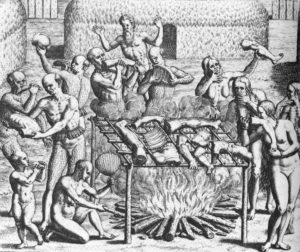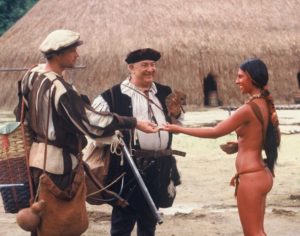Movie of the Week: “Hans Staden”
How tasty was my little German
 It is a curious fact that most of brazilian children detest History of Brazil and are interested in Universal History. Perhaps because discovering about Ancient Egypt or Roman Empire is more interesting than knowing who composed the Provisional Triune or where the Balaiada happened. Maybe if there were more films like “Hans Staden”, things would be different.
It is a curious fact that most of brazilian children detest History of Brazil and are interested in Universal History. Perhaps because discovering about Ancient Egypt or Roman Empire is more interesting than knowing who composed the Provisional Triune or where the Balaiada happened. Maybe if there were more films like “Hans Staden”, things would be different.
I do not know the reason for this distortion, but I only came to know about one of the most important documents of Brazilian colonial history a few years ago: the German Hans Staden’s account of his stay in Brazil when he was taken prisoner by Tupinambá Indians. As important as Pero Vaz de Caminha’s letter, Staden’s narrative differs from it because it is a description of facts and customs, bringing the vision of Indian culture with a wealth of detail not found elsewhere. Except for Monteiro Lobato, who made a recount of Staden’s book, the saga of the German was omitted by the luminaries of brazilian historiography.
 Hans Staden embarked as artillery man on Spanish ships, having visited Brazil twice. The first time he was in Pernambuco, and the second, he embarked in Seville on the expedition of Diego Sanabria, the new Governor-designate of Paraguay.The expedition was divided into two sections, Hans Staden in the first. It was a fleet composed by three ships, taking 200 people under the command of Juán de Salazar y Spinoza, that landed in the Island of Santa Catarina on 25 of November of 1549.
Hans Staden embarked as artillery man on Spanish ships, having visited Brazil twice. The first time he was in Pernambuco, and the second, he embarked in Seville on the expedition of Diego Sanabria, the new Governor-designate of Paraguay.The expedition was divided into two sections, Hans Staden in the first. It was a fleet composed by three ships, taking 200 people under the command of Juán de Salazar y Spinoza, that landed in the Island of Santa Catarina on 25 of November of 1549.
The three ships were shipwrecked, and the survivors of the crumbling expedition were divided, part going to Paraguay by land and others, including Staden, to St. Vincent. There, Staden served as an artillery instructor for the Portuguese.When he was about to return to Europe, Staden was captured by the Tupinanbás Indians, allied with the French. Even claiming that he was not Portuguese, Staden was taken to the village of Koniambebe, where he began to stay for nine months, always on the verge of being devoured.
 More than a barbaric custom, the anthropophagy belonged to the culture of countless indigenous peoples of our continent. Similar to many African and aboriginal tribes, there was a belief that, by eating the enemy, some of its qualities would pass to the devourer.So much so that the barbecue candidates were prisoners of war who spent a good deal of time with their captors. It was common for the prisoner to have a wife and participate in all the activities and social events of the tribe, culminating in the party where he was the honored guest and also main dish.
More than a barbaric custom, the anthropophagy belonged to the culture of countless indigenous peoples of our continent. Similar to many African and aboriginal tribes, there was a belief that, by eating the enemy, some of its qualities would pass to the devourer.So much so that the barbecue candidates were prisoners of war who spent a good deal of time with their captors. It was common for the prisoner to have a wife and participate in all the activities and social events of the tribe, culminating in the party where he was the honored guest and also main dish.
Thanks to every maneuver he could make, the German was able to postpone his death for nine months until he gained freedom through the commander of a French ship.After returning to Europe, he wrote his experience in the book “Hans Staden: The True Story of His Captivity”, which became a best seller when published in 1557. There were numerous editions in German, Latin and French. The book was composed of two parts, the first one dedicated to the narrative of the two shipwrecks and to the captivity with the Tupinambás.
 In the second part, Staden makes a precious ethnographic description of the Tupinambá people, including family and social customs, political practices, religion and, of course, cannibalism. This study was of great importance, since the Tupinambá culture dominated all the Southeast of Brazil and its language, called “general”, was widely used by the colonizers.
In the second part, Staden makes a precious ethnographic description of the Tupinambá people, including family and social customs, political practices, religion and, of course, cannibalism. This study was of great importance, since the Tupinambá culture dominated all the Southeast of Brazil and its language, called “general”, was widely used by the colonizers.
The first foray into Staden’s story in the movies was through the film “How Tasty Was My Little Frenchman”, a brilliant feature film by Nelson Pereira dos Santos, produced in 1970.The story was told with some differences, both in the nationality of the main character, as well as in the climax, literally anthropophagic.Perhaps symbolizing the hope that our culture would be able to overlap with that of the settlers.
 In this version of 1999, the script was faithful to the original text, both in the facts and in the recreation of the time. The film was shot in Ubatuba, in an uninhabited region, and a scenographic village was built with every possible detail. The cast was brilliant, especially in scenes of group activities, such as dances, rituals and war actions.The cast spent months studying the Tupi language with the help of a linguist, and faced additional difficulties such as near-permanent nudity during filming.
In this version of 1999, the script was faithful to the original text, both in the facts and in the recreation of the time. The film was shot in Ubatuba, in an uninhabited region, and a scenographic village was built with every possible detail. The cast was brilliant, especially in scenes of group activities, such as dances, rituals and war actions.The cast spent months studying the Tupi language with the help of a linguist, and faced additional difficulties such as near-permanent nudity during filming.
The dialogues are almost all in Tupi, with a few words in Portuguese and French, and the opening and closing narrated in the first person in German.This linguistic salad, contrary to what might seem, provides a climate of realism that is only broken with the unnecessary intrusion of Cláudia Liz as Marabá, and Sérgio Mamberti as a Jewish-French dealer.
 The film has everything in the right measure, safe direction of Luís Alberto Pereira, perfectly integrated actors, the interesting soundtrack of Marlui Miranda and Lelo Nazario, with indigenous songs, and mainly a believable story, adapted in a brilliant script.”Hans Staden” was awarded in the festivals of Brasília, BR Brazilian Cinema, Brazilian Cinema of Miami, Luso Brasileiro and Recife.
The film has everything in the right measure, safe direction of Luís Alberto Pereira, perfectly integrated actors, the interesting soundtrack of Marlui Miranda and Lelo Nazario, with indigenous songs, and mainly a believable story, adapted in a brilliant script.”Hans Staden” was awarded in the festivals of Brasília, BR Brazilian Cinema, Brazilian Cinema of Miami, Luso Brasileiro and Recife.
The DVD edition is not wonderful, but it is in the Versatile standard: Full Screen, 2.0 sound format and subtitles in Spanish, French, English and Portuguese. As extras, notes about Hans Staden and the production, trailer, a documentary of the TV Cultura about the film, isolated soundtrack and some other curiosities.
 “Hans Staden” is a dry and faithful portrait of brazilian colonial history, without judgments, emotions or spectacular adventures. It is an enlightened and picturesque view of an era in our history, where the Indians still had strength and power, little affected by the greed and vices of the white man.It deserved a better edition, but still worth checking out.
“Hans Staden” is a dry and faithful portrait of brazilian colonial history, without judgments, emotions or spectacular adventures. It is an enlightened and picturesque view of an era in our history, where the Indians still had strength and power, little affected by the greed and vices of the white man.It deserved a better edition, but still worth checking out.
Original title: “Hans Staden”






